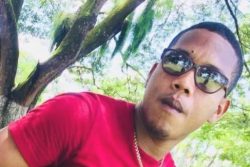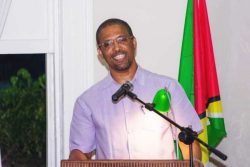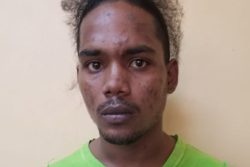Chief of Staff of the Guyana Defence Force (GDF) Commodore Gary Best is concerned that two Buxton men were taken into custody by the joint services without wounds on their bodies but emerged from the lock-ups beaten and bruised, allegedly by the men in uniform.
Speaking at a news conference at Camp Ayanganna yesterday Best took the same stance like Acting Commissioner of Police, Henry Greene, not admitting army ranks might have mistreated Victor Jones and Patrick Sumner, but insisting that an investigation is ongoing to determine how the men sustained the wounds. However, he acknowledged that it had been some three months since the incident and it was time that some closure was brought to the case. “I am not aware of people being tortured, what I saw were marks of violence on their bodies,” Best said. He maintained that the military did not condone torture of any citizen.
Asked whether in the process of interrogation the military would normally beat and burn suspects, Best replied in the negative, explaining that interrogation was a process driven by questions and answers. “I don’t know that the army beat or burn people to get answers. Acts of violence are not tolerated.”
It was late in September that Jones and Sumner were released from the Eve Leary lock-ups, after being detained for about three days, with their genitals seared and their bodies lacerated with burns and bruises. They alleged that they sustained the injuries at the hands of policemen and soldiers on the Linden-Soesdyke Highway.
The men had told this newspaper that they were first taken to Camp Ayanganna, then transferred to the Crimi-nal Investigation Department at Eve Leary where they were questioned about their lifestyles before being asked whether they knew the gunmen in Buxton. After spending some time at Eve Leary, the men said, they were then taken to the Brickdam Police Station where they spent the night in the lock-ups. The men had said the next day they were chained and taken to what appeared to be a military camp on the Linden-Soesdyke Highway. They alleged that they were clubbed with pieces of wood and shackled to posts. “They really beat us and I think at one time they would a kill I,” Sumner had told this newspaper. He said during the ordeal policemen threw a corrosive liquid on their bodies as well as gunpowder. They were also placed facedown on a sheet of cardboard and had their feet bound and eyes blindfolded while in this position, and were beaten on their heads. The men said they were also thrown into a pool of water on the highway.
The torture allegations came less than a year after the government submitted a report to the United Nations Committee Against Torture (CAT). After consideration of the submission, CAT delivered its conclusions and recommendations on December 7 last year.
CAT said it was concerned about widespread reports of police brutality, the use of force and firearms by the police and the lack of accountability of the force. CAT recommended that Guyana should ensure that the circumstances under which police officers are authorized to use force are exceptional and clearly defined and that members of the force receive appropriate training on the use of force and firearms. It added that Guyana should also take “effective steps to guarantee the accountability of the Guyana Police Force and, to this effect, carry out prompt, impartial and effective investigations, try the perpetrators of acts of abuse and, when convicted, impose appropriate sentences and adequately compensate the victims.” It also said that in relation to torture, Guyana should provide in its next periodic report, detailed data on torture complaints against law enforcement personnel and “on the related investigations, prosecutions and criminal and disciplinary sanctions.”








